Effective Backlink Building Guide – SEO Optimization for 2025
- Published on

- What is a Backlink?
- How Backlinks Work
- Benefits of Backlinks for Your Website
- Improve Search Engine Rankings
- Increase Organic Traffic
- Build Trust and Authority
- Speed Up Indexing
- Support Marketing Strategies and Increase Brand Awareness
- Boost Conversion Rates
- Common Terms Related to Backlinks
- What is PR (Page Rank)?
- What are DA (Domain Authority) and PA (Page Authority)?
- What is Anchor Text?
- What is a Dofollow Backlink?
- What is a Nofollow Backlink?
- How to Build Effective Backlinks
- Place Backlinks on High PR Websites
- Place Backlinks on High DA and PA Websites
- Use Websites with High Traffic
- Use Websites in the Same Niche
- Place Backlinks Within Content
- Use Dofollow Links
- Get Links from .gov and .edu Sites
- Combine Strategies for Maximum Effectiveness
- Types of Backlink Models
- What is the Backlink Wheel Link Model?
- What is the Backlink Pyramid Link Model?
- What is the Backlink Star Link Model?
- Choosing the Right Model for Your SEO Strategy
- Step-by-Step Guide to Building Backlinks
- Step 1: Analyze Competitors
- Step 2: Identify Target Backlinks
- Step 3: Create High-Quality Content
- Step 4: Outreach and Collaboration
- Step 5: Place Backlinks on Quality Sources
- Step 6: Monitor and Evaluate Performance
- Step 7: Maintain and Expand Links
- Key Considerations When Building Backlinks
- Avoid Buying Backlinks
- Diversify Backlink Sources
- Don’t Overuse Nofollow Backlinks
- Regularly Check Backlink Quality
- Balance Dofollow and Nofollow Links
- Avoid Links from Irrelevant Websites
- Don’t Create Too Many Backlinks in a Short Time
- Choose the Right Backlink Placement
- Optimize Anchor Text
- Avoid Spammy Linking Practices
- Backlink Checker Tools for SEO
- Ahrefs
- SEMrush
- Moz Link Explorer
- Google Search Console
- Majestic SEO
- Ubersuggest
- Broken Link Checker
- Linkody
- Choosing the Right Tool for Your Needs
- Conclusion
What is a Backlink?
Backlink is a link from another website pointing to your website. It is an extremely important factor in SEO (Search Engine Optimization), used by search engines like Google to evaluate the credibility, quality, and ranking of a website on the search engine results pages (SERPs). Each backlink acts as a "vote" for your content, signaling that it is valuable and trustworthy.
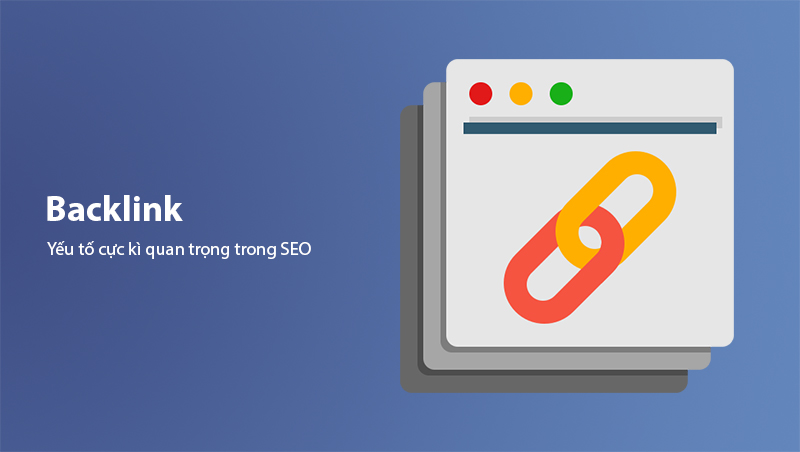
How Backlinks Work
When a website links to yours, search engines consider:
- The quality of the linking source: Links from reputable websites like .gov or .edu domains usually carry more weight.
- Relevance: Backlinks from sites related to your industry or content have a more positive impact.
- Link type (Dofollow/Nofollow): Only Dofollow links pass SEO value directly.
In the following sections, we’ll dive deeper into the benefits of backlinks and how to develop an effective backlink strategy to optimize your website’s ranking.
Benefits of Backlinks for Your Website
Backlinks are not just a technical aspect of SEO; they also bring significant benefits to help your website thrive online. Below are the key advantages of backlinks:
Improve Search Engine Rankings
Search engines like Google treat backlinks as a vote of confidence that your website content is valuable. Backlinks from authoritative websites can boost your keyword rankings on SERPs, which is particularly useful for competing in high-competition industries.
Example: A backlink from a gov.vn page can significantly improve your ranking for key terms in the tech industry.
Increase Organic Traffic
Backlinks from high-traffic websites can directly drive organic traffic to your site. Visitors clicking through these links are potential customers or loyal readers.
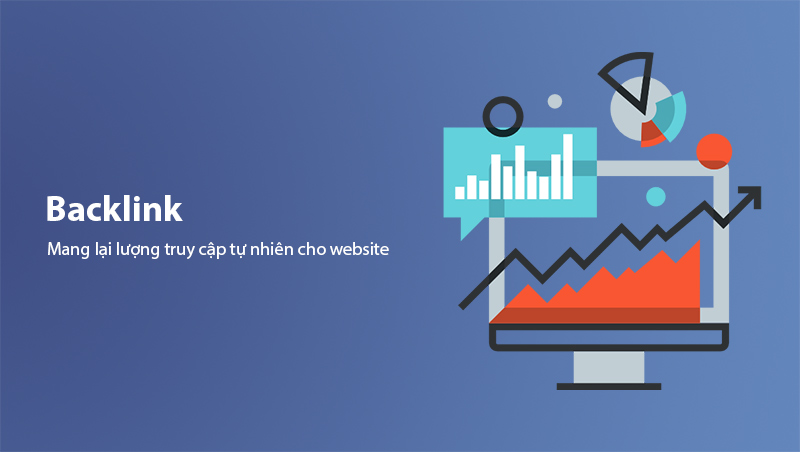
Note: Placing backlinks on relevant websites can improve your click-through rate (CTR) and reduce your bounce rate.
Build Trust and Authority
Backlinks from reputable websites help you build a strong brand and increase trustworthiness in the eyes of both users and search engines. A website linked by high-quality sites is often perceived as more reliable and professional.
Speed Up Indexing
Search engines use links to discover and index new web pages. If your site receives a backlink from a frequently indexed page, search engine bots are likely to visit your site faster, making your new content appear on search results sooner.
Explore more ways to speed up website indexing at: https://riverlee.vn/en/blog/what-is-google-index
Support Marketing Strategies and Increase Brand Awareness
Backlinks not only improve SEO but also support your marketing campaigns. When an authoritative site mentions your brand or content, it increases visibility and builds credibility in your industry.
Example: An article on vnexpress.net with a backlink to your website not only improves SEO but also captures the attention of a wide audience.
Boost Conversion Rates
When backlinks are placed on relevant sites, visitors coming from those sources are more likely to have higher conversion rate, such as making a purchase or signing up for services. This makes backlinks a powerful tool for achieving business objectives.
Common Terms Related to Backlinks
Understanding backlinks and how to build a linking strategy involves encountering several important technical terms. Knowing these terms will help you optimize your SEO efforts effectively.
What is PR (Page Rank)?
Page Rank (PR) is an algorithm developed by Google to evaluate the quality and importance of a webpage based on the number and quality of backlinks it receives. Although Google no longer publicly shares this metric, PR remains an important factor in determining backlink value.
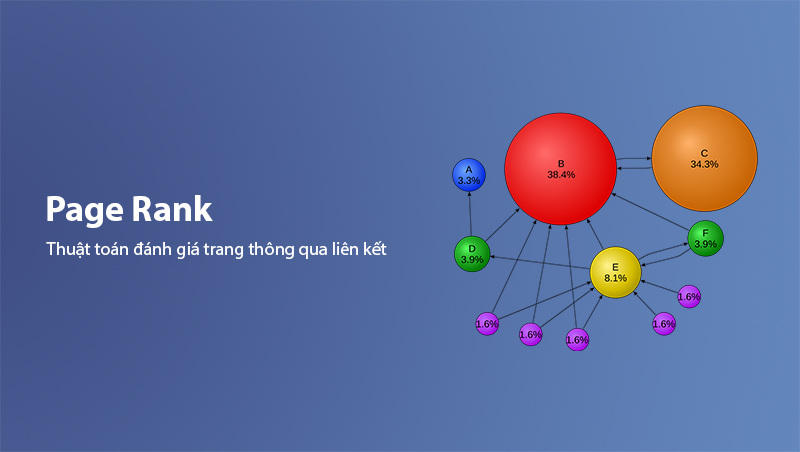
Note: Placing backlinks on pages with high PR can boost your website's authority.
What are DA (Domain Authority) and PA (Page Authority)?
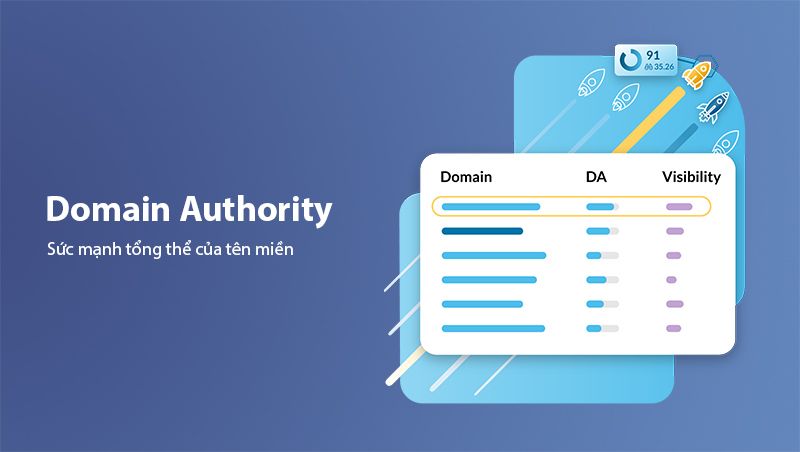
- DA (Domain Authority): A metric developed by Moz to measure the overall strength of a domain, ranging from 1 to 100. A high DA indicates that the domain is reputable and competitive in search results.
- PA (Page Authority): Measures the strength of an individual page on a website, also on a scale of 1 to 100.
Backlinks from sites with high DA and PA provide greater SEO value.
What is Anchor Text?
Anchor Text is the clickable text in a hyperlink. Anchor text is typically used to describe the content of the linked page, helping both users and search engines understand the destination.
Example: In the sentence "Learn more about SEO," the word "SEO" is the anchor text.
Note: Using keyword-rich anchor text can improve the ranking for those keywords.
What is a Dofollow Backlink?
A Dofollow Backlink is a type of link that passes SEO value (link juice) from the linking page to the target page. This is the most important type of link for SEO because it directly impacts search rankings.
Benefits:
- Increases Domain Authority and Page Authority.
- Improves keyword rankings.
What is a Nofollow Backlink?
A Nofollow Backlink does not pass SEO value directly to the target page as it includes the HTML attribute rel="nofollow". However, Nofollow backlinks still offer value by:
- Attracting referral traffic.
- Increasing brand awareness.
- Diversifying your backlink profile to avoid over-optimization penalties from Google.
Example: Links from blog comments or forums are often Nofollow.
Understanding these terms will help you devise an effective backlink strategy while avoiding common mistakes. In the next section, we’ll explore effective ways to build backlinks for SEO and website growth.
How to Build Effective Backlinks
Building backlinks is not just about creating links from other sites to yours; it’s about ensuring the quality and relevance of those links to maximize SEO performance. Here are some effective methods for building quality backlinks:
Place Backlinks on High PR Websites
Websites with high Page Rank (PR) are often seen as more credible and authoritative by Google. Placing backlinks on these pages can significantly improve your rankings.
Example: Backlinks from major news sites like vnexpress.net or popular forums can strengthen your website’s authority.
Place Backlinks on High DA and PA Websites
As mentioned earlier, Domain Authority (DA) and Page Authority (PA) are critical metrics for evaluating site quality. Backlinks from high DA and PA sites enhance your website’s authority and strength.

How to Do It:
- Look for websites with DA > 50 to build links.
- Use tools like Moz or Ahrefs to check DA and PA metrics.
Use Websites with High Traffic
Websites with high traffic not only improve rankings but also bring organic traffic to your site. Visitors from these sources can become potential customers or loyal readers.
Tip: Prioritize placing backlinks on sites with consistent traffic and relevance to your niche.
Use Websites in the Same Niche
Backlinks from websites in the same niche carry more weight because they help search engines better understand your field. These links create a relevant content ecosystem, boosting SEO more effectively.
Example: If you’re in the furniture business, place backlinks on blogs about interior design or e-commerce platforms in the same industry.
Place Backlinks Within Content
Backlinks placed directly within content articles often carry more value than those in footers or sidebars. They help users access information easily and increase click-through rates.
Example: An article on "SEO Optimization Tips" on a reputable website linking to your in-depth post will attract higher-quality traffic.
Use Dofollow Links
Dofollow backlinks are essential for passing SEO value (link juice). However, balance Dofollow and Nofollow links to avoid being flagged by search engines for over-optimization.
Get Links from .gov and .edu Sites
Backlinks from .gov and .edu sites are often considered highly authoritative because they originate from government or educational institutions.

Tips:
- Build relationships with organizations or schools to gain links from these sites.
- Provide valuable resources or content to earn natural backlinks from them.
Combine Strategies for Maximum Effectiveness
To achieve the best results, combine multiple backlink-building methods and monitor their performance using tools like Ahrefs, Google Search Console, or SEMRush. In the next section, we’ll dive into backlink models and how to apply them to your SEO strategy.
Types of Backlink Models
Backlink models are strategies for structuring links between websites to optimize SEO performance. Here are the most common models with their pros and cons.
What is the Backlink Wheel Link Model?
The Backlink Wheel Link Model is a strategy where websites link to each other in a circular fashion while all linking back to the main site.
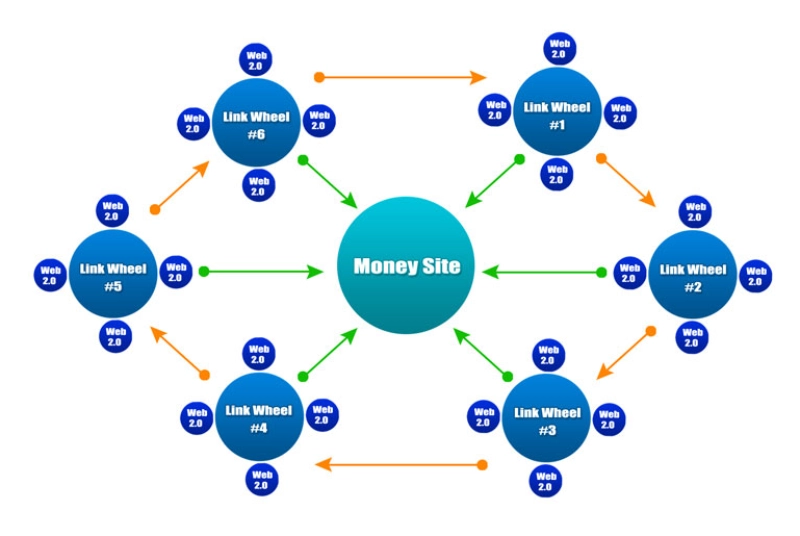
How It Works:
- Website A → Website B → Website C → Website A, and all link to the main site (money site).
Pros:
- Distributes link equity evenly among participating websites.
- Helps the main site gain authority from multiple sources.
Cons:
- If not executed carefully, it may be flagged by Google as spam.
What is the Backlink Pyramid Link Model?
The Backlink Pyramid Link Model builds backlinks in a tiered structure. The top tier (Tier 1) consists of high-quality links pointing directly to the main site, while lower tiers (Tier 2, Tier 3) support and amplify the upper tiers.
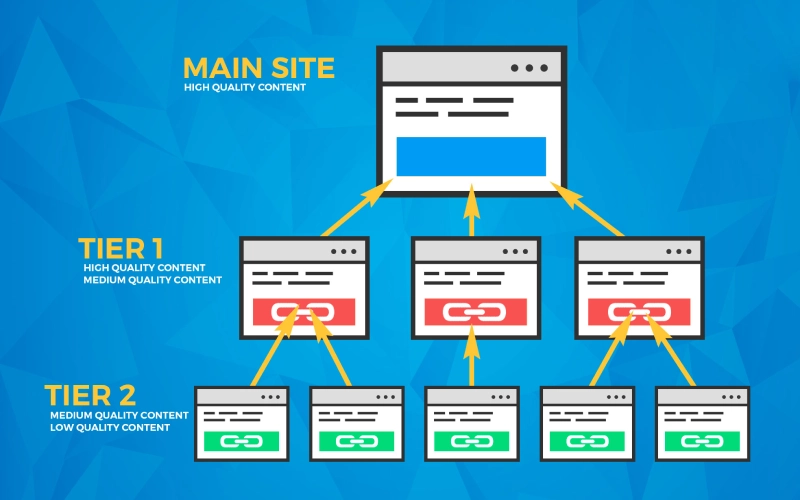
How It Works:
- Tier 1: Backlinks from authoritative, high-quality sites pointing to the main site.
- Tier 2: Backlinks from blogs, forums, or secondary websites pointing to Tier 1.
- Tier 3: Backlinks from sources like comments, social media, or articles pointing to Tier 2.
Pros:
- Reduces the risk of Google penalties as Tier 1 links are of high quality.
- Boosts link equity indirectly to the main site.
Cons:
- Requires significant time and effort to build all tiers effectively.
What is the Backlink Star Link Model?
Backlink Star Link is a model where multiple websites link directly to the main site without linking to each other.
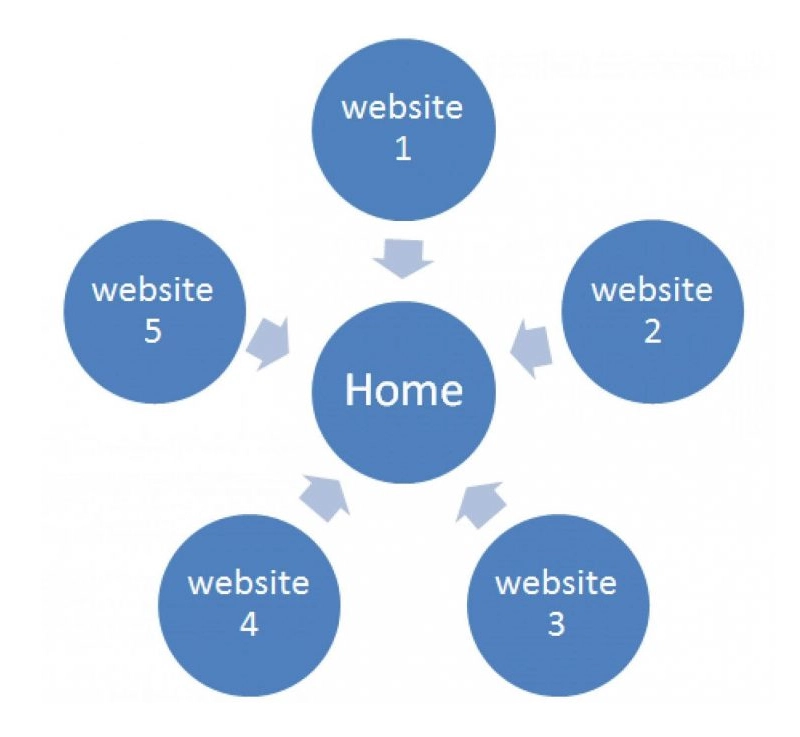
How it works:
- Website A, B, C, D → Main site.
Advantages:
- Easy to manage.
- Reduces the risk of being flagged by Google as unnatural linking.
Disadvantages:
- Requires a large number of high-quality websites linking to the main site.
Choosing the Right Model for Your SEO Strategy
Depending on your SEO goals and resources, you can choose the most suitable model or combine them for maximum effectiveness. In the next section, we’ll provide a detailed guide to building quality backlinks, helping you implement an effective strategy.
Step-by-Step Guide to Building Backlinks
To build a quality backlink system, you need a clear strategy and careful execution. Below is a step-by-step process to help you create effective links, optimize SEO, and grow your website.
Step 1: Analyze Competitors
Before starting your backlink strategy, analyze your competitors’ linking methods to learn and identify opportunities.
How to do it:
- Use tools like Ahrefs, SEMRush, or Moz to find out:
- Which backlinks are driving traffic to competitors.
- Accessible linking sources.
- DA, PA, and traffic metrics from websites linking to competitors.
Benefits: Understanding your competitors’ link-building strategies helps you optimize your own.
Step 2: Identify Target Backlinks
Not all backlinks provide equal value. Prioritize backlinks from sources like:
- Reputable websites: Sites with high DA and PA, and good PR.
- Same niche: Websites with content directly related to your industry.
- High traffic: Trusted websites with significant traffic.
Example: If you’re in the fashion business, target blogs, fashion magazines, or large e-commerce sites.
Step 3: Create High-Quality Content
Content is key to attracting natural backlinks and convincing other websites to link to yours.
Tips:
- Write in-depth articles: Create valuable, shareable, and reference-worthy content.
- Infographics: Attractive and informative infographics are more likely to receive natural backlinks.
- Update content regularly: Continuously improve and refresh your articles to maintain relevance in search results.
Step 4: Outreach and Collaboration
Reach out to web admins or bloggers to propose linking opportunities.
How to do it:
- Send concise, professional emails explaining the value your content offers.
- Suggest linking to your content if it’s relevant to theirs.
Example: "I noticed your article on 'Choosing the Right Domain Name for SEO' is highly insightful. My article on 'Comprehensive SEO Guide' could be a valuable addition. Would it be possible to contribute this content to your post?"
Step 5: Place Backlinks on Quality Sources
Some effective sources for placing backlinks include:
- Blogs: Place backlinks within articles or in the comments section (if appropriate).
- Forums: Participate in relevant discussions and share links.
- Social media: Share content on platforms like Facebook, LinkedIn, and Twitter.
- Resource pages: Submit your link to curated resource pages.
Step 6: Monitor and Evaluate Performance
Backlink building isn’t a "set it and forget it" strategy. You need to continuously monitor and evaluate link performance.
How to do it:
- Use Google Search Console to track new backlinks.
- Analyze link quantity and quality with Ahrefs or SEMRush.
- Measure traffic and ranking improvements from backlinks.
Step 7: Maintain and Expand Links
Maintain relationships with reputable websites and continuously expand new backlink sources. Don’t forget to:
- Update content to stay relevant.
- Build long-term relationships with strategic partners.
By following this process, you can create a strong backlink strategy, improve SEO rankings, and significantly increase traffic. In the next section, we’ll highlight key considerations when building backlinks to avoid common pitfalls.
Key Considerations When Building Backlinks
Building backlinks is a crucial part of any SEO strategy, but improper execution can harm your website. Below are important considerations to ensure you optimize backlinks effectively and avoid potential risks.
Avoid Buying Backlinks
Google’s algorithms, such as Penguin, detect and penalize unnatural link-buying behavior. Purchasing backlinks from untrustworthy sources can lead to ranking drops or even removal from search results.
Tip: Focus on building natural links through quality content and effective outreach strategies.
Diversify Backlink Sources
Having backlinks from diverse sources makes your website's backlink profile appear natural and trustworthy.
Example: Combine backlinks from:
- Blogs.
- Forums.
- Social media.
- Large news websites.
Note: Avoid relying too heavily on a single source, as this can be flagged as spam.
Don’t Overuse Nofollow Backlinks
While nofollow backlinks are valuable for diversifying your backlink profile, they don’t directly contribute to SEO benefits. Ensure that the majority of your backlinks are dofollow for maximum impact.
Regularly Check Backlink Quality
Not all backlinks are beneficial. Links from spammy, untrustworthy, or irrelevant websites can negatively affect your SEO rankings.
How to check:
- Use Google Search Console to track new backlinks.
- Disavow low-quality links using Google’s disavow tool.
Balance Dofollow and Nofollow Links
A natural backlink profile requires a balance between dofollow and nofollow links. Using only dofollow links may raise suspicion of over-optimization.
Avoid Links from Irrelevant Websites
Backlinks from sites unrelated to your niche offer little value and can even decrease your website’s credibility.
Example: If you’re in the furniture business, a backlink from a tech site may be considered unnatural.
Don’t Create Too Many Backlinks in a Short Time
Building too many backlinks too quickly can make Google suspect spammy behavior.
Tip: Build links steadily and naturally, matching your website’s growth.
Choose the Right Backlink Placement
Backlinks placed in locations like article content or header sections often carry more value than those in footers or sidebars.
Optimize Anchor Text
Using appropriate anchor text helps search engines better understand the target page. However, avoid overusing exact-match anchor text, as this may result in penalties from Google.
Good example: "Check out our complete SEO guide."
Bad example: "SEO" repeated excessively.
Avoid Spammy Linking Practices
Steer clear of spammy techniques such as:
- Linking from expired domains.
- Spamming blog comments or irrelevant forums.
Consequence: These practices not only damage your website’s reputation but may also lead to severe penalties from Google.
By following these principles, you can build a safe and effective backlink system while avoiding unnecessary risks. In the next section, we’ll explore popular backlink analysis tools to support your SEO strategy.
Backlink Checker Tools for SEO
Monitoring and analyzing backlinks is an essential part of an SEO strategy. Backlink checker tools help you assess link quality, detect potential issues, and optimize your link-building strategy. Below is a list of the most popular and effective tools.
Ahrefs
Ahrefs is one of the most powerful tools for backlink analysis. It provides detailed information about links pointing to your website and your competitors.
Key features:
- Analyze the total number of backlinks and their sources.
- Assess backlink quality using Domain Rating (DR) and URL Rating (UR).
- Analyze anchor text to optimize your keyword strategy.
Benefit: Using Ahrefs helps you identify high-quality backlinks to improve your SEO.
SEMrush
SEMrush is not just an SEO tool but a comprehensive backlink analysis platform. With SEMrush, you can track your link profile and evaluate competitor strategies.
Key features:
- Analyze backlinks based on the Authority Score.
- Monitor backlink history over time.
- Detect broken links.
Note: SEMrush is highly useful for building and maintaining a healthy backlink profile.
Moz Link Explorer
Moz Link Explorer specializes in backlink analysis and link strength measurement.
Key features:
- Evaluate Domain Authority (DA) and Page Authority (PA) metrics.
- Analyze which sources provide the most valuable links.
- Detect and manage harmful links.
Tip: Use Moz to identify strong backlink sources and eliminate bad links.
Google Search Console
Google Search Console is a free tool provided by Google to monitor backlinks pointing to your website.
Key features:
- View a list of websites linking back to your site.
- Analyze the number of backlinks and the most linked pages.
- Detect and resolve issues related to invalid links.
Benefit: This is a basic yet effective tool, especially for beginners.
Majestic SEO
Majestic SEO is a specialized tool for backlink analysis, focusing on metrics like Trust Flow (TF) and Citation Flow (CF).
Key features:
- Classify backlinks based on quality and reliability.
- Identify websites with high Trust Flow for link placement.
- Visualize link flow through graphical representations.
Tip: Use Majestic to evaluate the value of each backlink.
Ubersuggest
Ubersuggest, developed by Neil Patel, is a free tool suitable for small businesses and individuals.
Key features:
- Track the number of backlinks and referring domains.
- Analyze SEO metrics like DA and PA.
- Suggest new link-building opportunities.
Benefit: This tool is user-friendly and provides basic backlink insights.
Broken Link Checker
Broken Link Checker helps you identify broken links on your website or others to capitalize on replacement opportunities.
Key features:
- Quickly detect broken links.
- Suggest repairs or link replacements.
Application: Leverage broken links on competitor websites to build quality backlinks.
Linkody
Linkody focuses on automating backlink monitoring and management.
Key features:
- Monitor backlinks 24/7.
- Receive notifications for new or lost links.
- Assess backlink quality using SEO metrics.
Tip: Use Linkody to ensure you don't miss any changes in your backlink profile.
Choosing the Right Tool for Your Needs
No single tool suits everyone, so choose based on your needs and budget. If you’re just starting, Google Search Console or Ubersuggest are good options. For more advanced strategies, Ahrefs or SEMrush offer comprehensive features.
With these tools, you’ll gain a clear understanding of your backlink system and how to optimize your strategy for the best SEO results. Start building and managing backlinks systematically to ensure sustainable website growth.
Conclusion
Backlinks are one of the core elements of an effective SEO strategy, playing a crucial role in improving search rankings, increasing traffic, and building website authority. However, building and managing backlinks require persistence, a clear strategy, and adherence to SEO principles set by search engines.
Start building a quality backlink system today to ensure your website not only ranks higher but also sustains growth in the ever-competitive online landscape.
Latest Posts

Lesson 26. How to Use break, continue, and return in Java | Learn Java Basics
A guide on how to use break, continue, and return statements in Java to control loops and program execution flow effectively.

Lesson 25. The do-while Loop in Java | Learn Basic Java
A detailed guide on the do-while loop in Java, including syntax, usage, examples, and comparison with the while loop.

Lesson 24. How to Convert Decimal to Binary in Java | Learn Basic Java
A guide on how to convert numbers from the decimal system to the binary system in Java using different methods, with illustrative examples.

Lesson 23. How to Use the While Loop in Java | Learn Java Basics
Learn how to use the while loop in Java with syntax, real-world examples, and practical applications in Java programming.
Related Posts

What is Domain Authority? 13-Step Guide to Improve DA Score for Your Website in 2025
Discover what Domain Authority is and its importance in SEO. A detailed guide on the 13-step process to effectively increase DA, from content research and technical optimization to building quality backlinks for a sustainable SEO strategy.

What is Page Authority? The Importance of Page Authority for SEO in 2025
Learn what Page Authority (PA) is and its role in SEO optimization to help improve your website's ranking on search engines in 2025.

What is Google Index? A Guide to 13 Ways to Speed Up Website Indexing in 2025
Discover what Google Index is and learn detailed guidelines on 13 effective ways to get your website indexed quickly and boost your SEO rankings on Google in 2025.
![What is Onpage SEO? 23+ Basic & Advanced Onpage Optimization Checklist [2025]](/blog-posts/seo-onpage/seo-onpage-thumb.jpg)
What is Onpage SEO? 23+ Basic & Advanced Onpage Optimization Checklist [2025]
Learn the concept of Onpage SEO and the 23+ basic to advanced Onpage optimization checklist to improve website quality and boost search rankings effectively.

